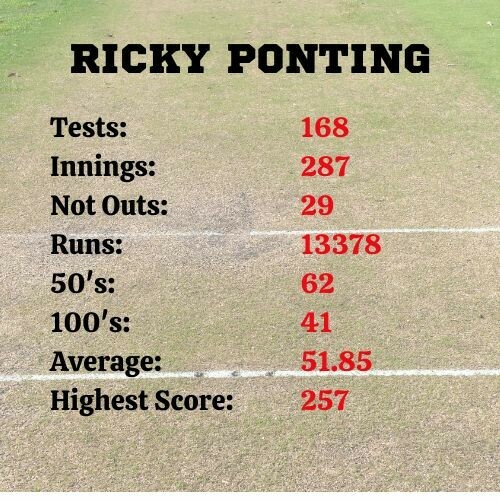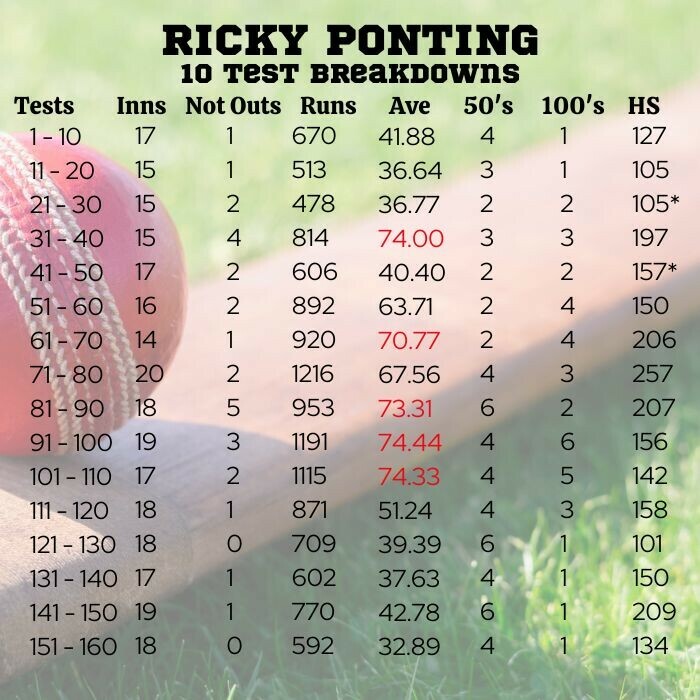Ricky Ponting, the man nicknamed ‘Punter’ by Shane Warne due to his love for betting on dog races, was one of the greatest batsmen to have played the game. Born in Launceston, in northern Tasmania, Ricky Pointing had sporting pedigree, with his uncle, Greg Campbell, playing Test Cricket in the late 80’s and early 90’s. In fact, it was his uncle, along with his father, who introduced a young Ricky to the game of cricket.

Ricky Ponting Tourism Victoria, CC BY 2.0, via Wikimedia Commons
When Ponting was 11, he played for the Mowbray Under 13’s, and during a five day long Northern Tasmania junior cricket competition, he scored four centuries and received his first bat sponsorship from Kookaburra.
Later, Ponting would help out with the scoreboard during Tasmanian Sheffield Shield matches, and after leaving school after grade 10, he became a groundsman.
Ponting’s star rose early; at 17, Rod Marsh called him the best 17 year old batsman he had ever seen, and before his 18th birthday, he made his debut for Tasmania, becoming the youngest Tasmanian to do so.
It wasn’t until he was 21 when he made his debut for Australia in a one day game against South Africa, in 1995. He only scored one run, batting at number six. He was in line to make his test debut during the famous tour to the West Indies in 1995, when Australia finally took the mantel as best test cricket team from the West Indies, but he was not chosen for the test side, although he did play a few one dayers on the tour.

His test debut would come in 1996 against the visiting Sri Lankan side in Perth. Ponting came in at the fall of the third wicket, and while any debut is nerve racking, the fact Australia had already scored 422 runs might have helped calm the nerves a little.
Or possibly, not at all, because his first ball was facing Muttiah Muralitharan, the bowler who would become the highest-wicket taker of all time. He edged it pass first slip for 4.
Ponting would end up getting out for 96, and that was a very dubious decision, as he was LBW to a ball that hit him on the thigh on probably the bounciest wicket in the world.
His next innings in his second test was almost as good – 71, but despite this good start to his career, by 45 tests in, his average sat at 40.50. This is not a terrible average by any stretch of the imagination, but merely an average average for a batter in the middle order.
The Ricky Ponting who would vie for the title as the second best batsman since Don Bradman with a number of fellow and future legends had shown glimpses of appearing, but he had, by no means, arrived.
Ricky Ponting’s Test Career … for the stats nerds.
Ricky Ponting’s career broken down into 10 Test sections to show rise and fall of form.
Here we go. This is what you’ve been waiting for. Stats.
With 13,378 runs from 168 tests, and 13704 runs from 375 one day internationals, Ricky Ponting has the most Test and One Day runs for an Australian, and 2nd most test runs and 4th most One Day runs for any batsman. He is the most successful captain to have played the game, with his 324 matches across the various formats bringing him 220 victories.
After his first 2 tests, when he averaged 83.50, Ponting didn’t return to the ‘50+ Average Club’ until his 66th test, and his average would never dip again below 50. After his 107th test, his average would hit it’s peak (not including his first 2 tests) of 59.99.
His best 10 innings stretch, from 25th July 2003 to 26 December 2003, would net him 952 runs, at an average of 119 (thanks to two not outs). During this stretch, Ponting would score his two highest scores, 257 and 242, both against India in successive tests.
Ponting’s worst 10 innings stretch was a couple of years before, from 27th February to 2001 to 2nd August 2001. During this period, he scored only 77 runs, for an average of 7.7. This included a top score of 17, and 5 single figure scores, including 3 ducks.
Ponting’s longest sequence of innings without a 50 was 13 (for comparison, Sachin Tendulkar’s was the same number), and his longest period without a century was 33 innings. There were 3 distinct and separate periods of his career where he averaged over 100 over the course of 10 innings, and also 3 distinct periods where he averaged less than 20 over the course of 10 innings.
He once went 51 innings without a duck, and his best continuous sequence of 20+ scores was 11 innings. His best continuous sequence of 50+ scores was 5 innings.
Ricky Ponting’s Two Greatest Innings:
140* (121) vs India, 2003 World Cup Final, Johannesburg
It was on the biggest stage that Ricky Ponting produced one of his greatest and most important innings, an innings that Wisden ranked as the 4th best One Day International innings of the 2000s.
India had gone into the final having lost only one game in that tournament, but that had been their Pool Match against Australia, where they had been dismissed for 125 and Australia had passed the total only 1 down with 166 balls to go.
Australia, on the other hand, were undefeated, and confidence was high.
Batting first, Adam Gilchrist and Matt Hayden got them off to a fast start, putting on 105 off just 14 overs, but two quick wickets by Harbhajan Singh left Australia 2/125 off 20 overs when Damien Martyn joined Ricky Ponting in the centre.
For a long time, Damien Martyn was the aggressor in the partnership, and Ricky Ponting the accumulator. Due to the quick and sizeable opening partnership, Ponting knew he had time to build an innings and he had confidence that he could cash in towards the end.
Damien Martyn reached his fifty first, scoring it off 46 balls, having hit six boundaries. Ponting would follow four overs later, having taken 74 balls to reach the minor milestone. Amazingly, Ponting had only hit one boundary at this stage.
But it was as if in passing his fifty a switch had been turned on. Ponting danced down the pitch for his next two balls, bowled by Harbhajan, hitting them both for six. He hit the second six so far, the ball got lost, and they had to replace it.
Come the 40th over, Australia had a fantastic launching pad; 2/250, with Damien Martyn on 64 from 63, and Ricky Ponting on 64 from 80, those two sixes added to the solitary four, as his only boundaries.
But they would not be his last. Ponting hit Ashish Nehra over square leg for six in the 41st over, then next over, he smashed off-spinner Dinesh Mongia into the stand over long on. Zaheer Kahn would be the next to feel Ponting’s wrath in the 44th over, with a flick to a knee-hit full toss going over midwicket.
Six number 6 would come at the beginning of the 48th over, with Ponting hitting a Srinath full toss over midwicket, and number 7 would come the next over, once again off Zaheer Khan – a pull off a short ball disappearing into the stands.
And finally, six number 8 would come with the penultimate ball of the innings, with a mighty whump sending the ball over long on off Javagal Srinath.
With a final ball four to finish proceedings, Ricky Ponting would end up on 140 not out, off 121 balls, with four 4’s and eight 6’s. Damien Martyn, who would later find out that he had batted with a broken finger, hit 88 off 84, in an unbeaten partnership of 234.
In the last 10 overs alone, Ponting scored 76 runs off 41 balls, leading Australia to 2/359.
India’s response would never really fire, although Virender Sehwag’s 82 off 81 showed fight. They would fall for 234, giving Australia a win by 125 runs.
156 v England, 2005 Ashes Series, Old Trafford
This is the innings that Ricky Ponting himself said he was the most proud of. An innings of great determination and grit. It wasn’t an innings that won a test, but it was one that saved one, although by the barest margin possible.
The 2005 Ashes Series in England has gone down as one of the greatest test series of all time. After years of being Australia’s whipping boys, England were fighting back. And although, not at their best, Australia weren’t about to give up the Ashes without a fight.
A first innings century by Michael Vaughan allowed England to compile an intimidating 444, and Australia were in a heap of trouble at 5/133 and then 6/186 when Shane Warne arrived at the crease. His 90 runs, along with 2 and a half hours of stoic defensive work by Jason Gillespie, took Australia to 302, which was still 142 behind.
England scored quickly – who says Bazball was invented only recently – scoring at 4.5 an over in piling on 280 declared for the loss of 6 wickets.
This left Australia a target of 423 runs to win, or 108 overs to play out for a draw.
When Ponting arrived at the fall of the first wicket, for 25, no one expected Australia to win. And few expected them to last the 108 overs. England were getting the most out of the dry pitch, finding dangerous reverse swing that was difficult for the Australian batsmen to counter.
But the Australian batsmen were fighting it out, although wickets still fell regularly. Matthew Hayden fell for 36, Damien Martyn for 19, Simon Katich for 12 and Adam Gilchrist for 4, to leave Australia 5/182 off 57.4 overs, with still 51 overs to go.
Future captain and future batting great, Michael Clarke, batting with back pain, came in at number 7.
At this time, Ponting was 79 runs. These came off 139 balls, which was not bad going, considering the situation of the game. As many a commentator has said when a team is fighting to bat out a draw, the best way to survive is to play your natural game.
And Ricky Ponting is a survivor.
At tea, on that final day, Ricky Ponting was on 91 runs, and Australia was 5/216. There were still 42 overs remaining to be bowled.
Ponting passed his century with a glorious cover drive off his 169th ball. On a day when no other batsman passed 40, Ponting was standing up.
The partnership would continue until there were 33 overs to go, but then Michael Clarke was bowled for 39, to bring Gillespie in to the crease.
He would last less than two overs, dismissed for a duck. With 31 overs, Australia only had 3 wickets left.
Shane Warne was now in to bat, and while a lot of batsmen might have considered shielding the tail ender from strike, Ponting didn’t. He put his trust in the skills of the legendary leg-spinner, and gave him his fair share of the strike.
Time passed, runs (which were inconsequential) ticked down, but so too did the overs. With 25 overs remaining, Flintoff joined Harmison, two of England’s most damaging bowlers. But Warne and Ponting held on. Ashley Giles came on for a change of pace with 20 overs to go, but that didn’t work, either.
The last hour arrived, with Australia still 7 down. Fifteen more overs remained. Despite the precarious of the situation, Australia scored 21 runs off the next 3 overs, although England contributed to this by keeping a very attacking field.
Flintoff came in to bowl, and in his second over of the spell, he dismissed Shane Warne, caught by the keeper off a ricochet off second slip’s knee.
9 overs, 2 wickets remaining, Brett Lee at the crease.
With 7 overs remaining Steve Harmison was brought on again, with Flintoff. His first over went for 8, but the final ball of his second over was a short ball to Ponting, going slightly down leg side, that he got a touch of the glove to.
It was the end of an epic rear guard innings. Against a dangerously swinging ball on a dry pitch, where no other batsman made it to 40 runs nor lasted 100 balls, Ricky Ponting had scored 156 runs, had lasted 275 balls, and had batted for nearly 7 hours.
But at that moment, none of that seemed to matter. He couldn’t believe he had got out with 4 overs remaining. He left to a standing ovation from the Old Traffic crowd, crossing paths with number 11 Glenn McGrath.
Ponting had no high hopes that McGrath would survive. He was resigned to losing the match, and felt like he had been the one to lose the match.
But no one told McGrath he was supposed to get out. Brett Lee faced up to the first of the last 4 overs, bowled by Andrew Flintoff, getting a four off the last ball.
Now it was McGrath’s turn, facing Steve Harmison. And while Ricky Ponting watched the dressing room TV, disconsolate, McGrath began to breathe hope back into the fight. He faced the entire over, even scoring a boundary, although it was an edge down to fine leg.
Two overs to go. Brett Lee facing Flintoff. Every ball was an event of its own, the 20,000 Old Trafford crowd on the edge of their seats, but each ball was met with a strong defensive bat, and the sixth was sent for four, although Lee had only wanted the 1, so that he could get the strike back for the last over.
One over to go. Glenn McGrath on strike to Steve Harmison. The first ball was down leg size, and McGrath didn’t play. The second ball was just outside off, and this time McGrath played and missed.
The third ball was full and on the pads, and McGrath pat it away for a single.
The fourth ball was again way down leg, and Brett Lee left it.
Two to go.
The fifth ball was just outside off, and with relief, Brett Lee left it again.
1 ball to go. 1 wicket to get.
Undoubtedly, Ricky Ponting and the Australian dressing room were riding every ball. Ponting, feeling like he had cost his team the game, would have been beside himself with tension but also hope.
The sixth and last ball of the test was a full toss on the stumps. Brett Lee clipped it away for four, and Australia saved a great match in an amazing series, and Ricky Ponting’s innings stood tall as testament to his courage, skill, grit and determination.
The Last Words
Ricky Ponting was a symbol of inspiration and pride for the people of Australia. From his early days in Launceston to his illustrious career on the international stage, Ponting epitomized the values of hard work, determination, and never-say-die attitude that resonate deeply with Australians. He wasn’t just a batsman; he was a leader who led by example, instilling a sense of belief and unity in his teammates.
His ability to perform under pressure, to overcome adversity, and to always strive for excellence set a benchmark for aspiring cricketers across Australia. Ponting’s passion for the game and his relentless pursuit of success served as a guiding light for those who played alongside him and those who watched him from the stands.
Beyond the boundaries of the cricket field, Ponting’s legacy lives on as a testament to the power of resilience and determination. He showed that with unwavering dedication and a never-give-up attitude, anything is possible.
Ponting didn’t just represent Australia on the cricket field; he embodied the spirit of the nation – resilient, courageous, and always ready to rise to the challenge.
We hope you have enjoyed this post. Our next post in this series on Cricket Legends will be on the great South African All-Rounder, Jacques Kallis.


